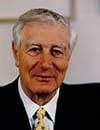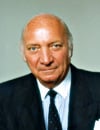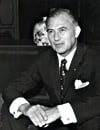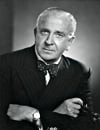Since its creation, IATA has been guided by a number of exceptional personalities, whose achievements make today's organization a successful and authoritative airline leader. IATA's history since 1945
2021 - Willie Walsh
2016 - 2021 Alexandre de Juniac
2011 - 2016 Tony Tyler
2002 - 2011 Giovanni Bisignani
1993 - 2002 Pierre Jean Jeanniot
1985 - 1992 Günter Eser
1966 - 1984 Knut Hammarskjöld
1946 - 1966 Sir William Hildred
Past leaders
2016 to 2021

Alexandre de Juniac was IATA's seventh Director General & CEO, joining the association with a long background in aviation. Under the rallying motif of "aviation is the business of freedom”, his tenure at IATA focused on sustainability, digital transformation, and building strong partnerships with governments.
He led significant advances in digital processes throughout the passenger journey to bring a seamless experience closer to reality and expanded the modernization of airline retailing with the adoption of the New Distribution Capability by major airlines around the world. De Juniac also oversaw the launch of the 25by2025 campaign to address gender imbalance in civil aviation.
De Juniac’s first years in office were marked by improvements in industry financial performance to historic levels. The industry was well-placed to continue to grow sustainably when the Coronavirus pandemic dealt a devastating blow in 2020.
In response, de Juniac ran IATA in crisis mode for his last year as Director General—attempting to steer the industry through a catastrophic fall in traffic as governments closed borders and imposed severe travel restrictions.
IATA history: the Business of Freedom
2011 to 2016
 Tony Tyler was the sixth person to lead the IATA. With over three decades of airline industry experience, Tyler was a strong advocate for a safe, secure, efficient and sustainable global air transport industry.
Tony Tyler was the sixth person to lead the IATA. With over three decades of airline industry experience, Tyler was a strong advocate for a safe, secure, efficient and sustainable global air transport industry.
Tyler was keen to engage all aviation stakeholders to achieve common goals. This was evident in two projects which IATA was undertaking with his leadership - New Distribution Capability and Smart Security.
Tyler also championed IATA’s commitment to addressing aviation’s impact on the environment. This effort led to passage of a milestone Resolution at IATA’s 69th Annual General Meeting in 2013, calling upon governments to reach a global agreement on a market-based measure (MBM) as a key tool to manage aviation’s carbon footprint and achieve the industry’s carbon-neutral growth target.
A passionate believer that aviation is a force for good in the world, Tyler was a tireless global campaigner on behalf of the industry. He carried with him a message that aviation delivers extensive social and economic benefits—supporting some 57 million jobs and enabling over $2.2 trillion of business annually.
Finally, he also oversaw a major internal restructuring of IATA to improve the association’s organizational effectiveness in delivering greater value to its members.
History: a Force for Good
2002 to 2011
 Giovanni Bisignani, Italian, joined IATA as Director General & CEO after a long career in various transport related businesses including Opodo, SM Logistics, Tirrenia di Navigazione and Alitalia.
Giovanni Bisignani, Italian, joined IATA as Director General & CEO after a long career in various transport related businesses including Opodo, SM Logistics, Tirrenia di Navigazione and Alitalia.
During his nearly 10 years with IATA, Mr. Bisignani drove major industry changes. The most important was making the IATA Operational Safety Audit (IOSA) a condition of IATA membership. This contributed to a 42% improvement in safety over the period 2000-2010.
Mr. Bisignani also started the Simplifying the Business (StB) initiative in 2004. During his tenure, this program converted the industry to e-ticketing and bar-coded boarding passes, made common-use self-service kiosks as an integral part of the travel experience and established the framework for 100% e-freight by 2015.
Giovanni Bisignani also mobilized the industry behind an ambitious strategy to deal with the impact of the industry’s carbon emissions on climate change. Airlines, airports, air navigation service providers and manufacturers committed to achieve carbon neutral growth by 2020 and cut emissions in half by 2050.
Finally, Mr. Bisignani strengthened IATA’s position as the voice of the industry, with firm advocacy and lobbying to focus government on long term issues for the viability of aviation. He was particularly outspoken on liberalization, taxation and environment.
History: ensuring the viability of air transport
1993 to 2002
 Pierre Jean Jeanniot, Canadian, was President and CEO of Air Canada prior to joining IATA as Director General & CEO.
Pierre Jean Jeanniot, Canadian, was President and CEO of Air Canada prior to joining IATA as Director General & CEO.
Mr. Jeanniot reformed IATA’s bureaucratic governance and organizational structure. This helped define IATA as aviation’s leading voice and the driver of a new strategic plan for the global industry.
Under his leadership, the industry agreed and achieved a target to cut the accident rate in half over 10 years. The roots of the IATA Operational Safety Audit (IOSA) were established with airline agreement to undertake periodic reviews of each airline’s safety and operating processes.
He brought the main airlines of the People’s Republic of China into IATA’s membership and established a strong IATA presence in Beijing.
Under his direction, IATA became a major supplier of products and services, primarily in the fields of technical, operations, financial services, training, and publications such as the Dangerous Goods Manual. IATA’s revenues increased ten-fold to USD300 million between 1992 and 2002. Membership dues were cut in half and the surplus was invested in membership services.
Mr. Jeanniot was directly involved in managing the 9/11 crisis, coordinating on behalf of the industry with authorities in the U.S., Europe and ICAO.
1985 to 1992
 Günter Eser, from Germany had a 30 year career at Lufthansa, ending with a post on its governing board before taking up the position of IATA’s Director General.
Günter Eser, from Germany had a 30 year career at Lufthansa, ending with a post on its governing board before taking up the position of IATA’s Director General.
The first in a series of airline executives to run the organization, Mr. Eser transformed IATA into a truly global association, expanding membership in Asia, Africa, the Middle East, Latin America and the former Soviet Union. IATA membership doubled to reach over 200 airlines.
Under his leadership, IATA launched its first commercial services, such as consulting services, marketing research, currency conversion, which allowed to reduce membership dues and invest in industry projects.
Mr. Eser notably led the first industry campaign tackling the growing issue of taxation.
1966 to 1984
 Knut Hammarskjöld, a Swedish diplomat, joined IATA from the European Free Trade Association where he held the position of Deputy Secretary General.
Knut Hammarskjöld, a Swedish diplomat, joined IATA from the European Free Trade Association where he held the position of Deputy Secretary General.
As IATA's Director General, Knut Hammarskjöld restructured key parts of the organization's activities, including those concerned with tariff coordination and compliance, to align with the emerging trends of market liberalization in the late seventies.
He launched the first billing and settlement system in Tokyo in 1972, which has evolved into today's successful BSP and CASS, facilitating financial transactions between passenger as well as cargo agents and the airlines.
Mr. Hammarskjöld also initiated the Program for Developing Nations that has evolved into IATA's training activity.
1946 to 1966
 Sir William Hildred, a British national, came to IATA from the Civil Aviation Office of Great Britain, where he held the position of Director General.
Sir William Hildred, a British national, came to IATA from the Civil Aviation Office of Great Britain, where he held the position of Director General.
The first IATA’s Director General, Sir William Hildred was instrumental in the establishment of commercial standards to support post-World War Two aviation.
The creation of the Multilateral Interline Traffic Agreement and the IATA Clearing House supported collaboration among airlines to facilitate global mobility. The introduction of different classes of fares and cheaper tickets, with tourist, economy and even excursion class also led to the greater accessibility of air transport.
Sir William also established the Traffic Conferences to align aviation's commercial activities with the international government framework that emerged from the Chicago Convention and the Bermuda Air Services Agreement.
Under Sir William's leadership, IATA worked closely with ICAO to develop the first Annexes to the Chicago Convention, which laid out the technical and safety standards for the industry.